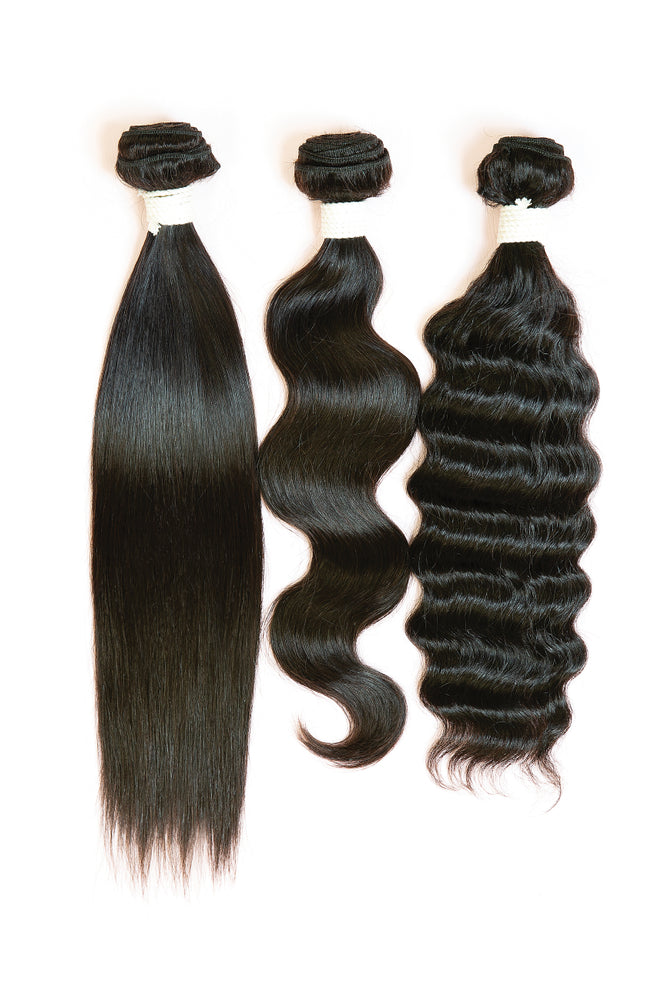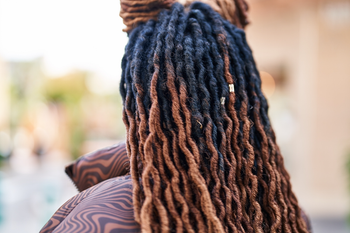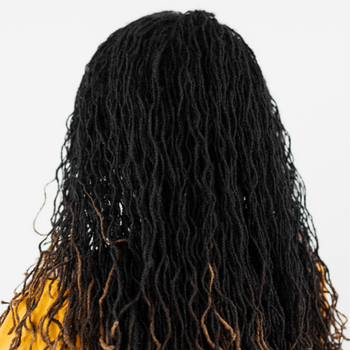

Are weaves bad for your hair? This question becomes increasingly important when we consider that 70% of the 30 million women suffering from hair loss in the United States are Black women. While weaves offer versatility and style options, many of us love that the hidden truth often remains unspoken in styling chairs nationwide.
Unfortunately, improper application of weaves and extensions can permanently damage your natural hair. Many people wonder: Do weaves damage your hair when installed correctly? Are sew-ins bad for your hair, even when done by professionals? The answer isn't straightforward. Tight braiding creates tension on hair follicles, and continuous wearing of these styles can lead to traction alopecia, a gradual hair loss that may or may not be reversible. In fact, with installation costs ranging from $400 to $1,000, the financial investment doesn't always protect you from the physical cost to your hair health.
Table of Contents
The Real Effects of Weaves on Natural Hair
Weaves can dramatically change your appearance, but beneath the glamour lies a complex relationship between extensions and your natural hair. Understanding this interaction is crucial for maintaining healthy hair in the long term.
How Weaves Interact With Your Scalp and Strands
The installation process requires pulling your natural hair tightly to create a secure foundation. This tension puts immediate stress on your hair follicles, potentially weakening them over time. Additionally, the extra weight of extensions creates a constant pulling force that your natural hair wasn't designed to support.
Your scalp – the foundation of hair growth – becomes partially covered and less accessible. This restricted environment can disrupt the natural balance of moisture and oil production in your scalp. Furthermore, improper drying after washing can create a breeding ground for bacteria, leading to that unmistakable mildew smell some weave-wearers experience.
Common Signs of Early Hair Damage
Recognizing damage early can prevent permanent hair loss. Be vigilant for these warning signs:
Broken hair around hairline: Short, frayed strands near temples or forehead
Scalp pain or irritation: Redness, burning, or persistent itching
Thinning edges: Baby hairs along your hairline are particularly fragile
Excessive shedding: More hair loss than usual when touching or washing
Bald spots: Particularly near attachment points
Nearly 60% of African American women in one study showed signs of advanced central hair loss with scarring. This statistic highlights the prevalence of these issues, yet they often remain unaddressed.
Are Sew-Ins Bad for Your Hair?
Sew-ins aren't inherently damaging – when appropriately installed and maintained correctly, they can protect your natural hair. The braided foundation allows air circulation that promotes growth, and tucking ends under extensions can help retain moisture.
Nevertheless, problems arise from improper application or care. Tight braiding, excessive weight, or leaving installations in too long significantly increases the risk of damage. A survey of over 50,000 stylists recommends keeping sew-ins for no more than eight weeks at a maximum.
The most concerning risk is traction alopecia – gradual hair loss caused by prolonged tension. Once hair follicles sustain damage, regrowth becomes impossible, resulting in permanent baldness. Two to three months is generally considered the maximum safe duration for any weave style before giving your natural hair a break.
Despite these risks, with proper installation, regular maintenance, and respecting time limits, weaves can be worn safely as part of your hair styling rotation.
What Causes Hair Damage from Weaves
Much like styling any hair, improper weave practices can cause severe damage to your natural tresses. Understanding the specific culprits behind weave-related hair loss is essential for protecting your locks.
Tight Braiding and Tension on Follicles
The foundation of most weave installations involves braiding your natural hair tightly to create a base. This constant pulling force can damage hair follicles, resulting in a condition known as traction alopecia. Dr. Timothy Quinn explains, "It's a condition that's caused by the hair being pulled too tight during the installation technique. The follicles are damaged and that person can have long-term hair loss".
Unfortunately, this tension often affects the hairline first, where strands are naturally more fragile. Over time, damaged follicles may cease producing hair altogether, leading to permanent baldness.
Improper Installation Techniques
Even beautiful weaves can hide destructive installation methods. Stylist Justin McPherson warns, "There have been a few cases where I've seen someone who has had them braided in too tightly. They also have had extensions put too close to the scalp. That will cause scalp irritation and hair loss".
Additionally, when tracks are sewn too close to your "leave out" hair, they can become visible and ruin the entire look. Heavy extensions exert excessive weight on your natural hair, essentially creating a constant tug-of-war with your follicles.
Leaving Weaves in Too Long
Many women keep weaves installed far longer than recommended. As your natural hair grows, the attachments move farther from your scalp, creating opportunities for snagging and pulling.
Moreover, leaving installations in place beyond 8 weeks can lead to matting and tangling above the attachment points. This happens because natural oils and styling products gradually break down adhesives, making removal increasingly difficult.
Do Sew-Ins Damage Your Hair?
Sew-ins don't inherently damage hair when properly installed and maintained. The critical factors are installation technique, duration, and aftercare. Weaveologist Shante Lewis notes, "In some situations, we have to send clients to a doctor. They have to seek medical attention".
Essentially, damage occurs primarily when weaves are applied incorrectly, maintained improperly, removed incorrectly, or worn beyond 8 weeks.
How to Prevent Hair Loss While Wearing Weaves
Protecting your natural hair while enjoying the versatility of weaves requires intentional care. With the right preventive measures, you can avoid the common pitfalls that make people ask, "Are weaves bad for your hair?"
Prep Your Hair Before Installation
Proper preparation creates a healthy foundation. First, thoroughly cleanse your hair with a gentle, sulfate-free shampoo to remove any buildup. Subsequently, apply a deep conditioning treatment to boost moisture and flexibility, reducing breakage risk. After conditioning, carefully detangle starting from the ends and working upward. Some experts recommend giving your hair a 3-to 5-day "breathing period" between styles to restore its natural balance.
Choose a Qualified Stylist
Your stylist selection might be the single most crucial factor in preventing damage. Rather than seeking the lowest price, invest in quality installation. During your appointment, communicate openly about any discomfort—weaves should never cause pain, headaches, or excessive tightness. These symptoms indicate potential traction alopecia development. A reputable specialist will provide thorough aftercare instructions and prioritize hair health alongside aesthetics.
Keep Your Scalp Clean and Moisturized
Even with protective styles, regular cleansing remains essential. For dry scalps, apply moisturizing oils like grapeseed or jojoba; for irritation, try tea tree oil or rosemary. Throughout your weave period, use a diluted shampoo or scalp cleansing spray specifically designed for protective styles. Always dry thoroughly under a hooded dryer after washing to prevent bacterial growth and unpleasant odors.
Avoid Heat Styling on Leave-Out Hair
Heat damage compounds weave-related stress, especially on delicate leave-out sections. Instead of daily heat styling, consider:
Twisting, braiding, or using decorative clips and headbands
Limiting flat iron passes and keeping the temperature below 400°F
Using extensions that match your natural texture
Switch Up Your Styles Regularly
Contrary to popular belief, "weave retightening" doesn't exist—attempting it causes further damage. To maintain hair health, take breaks between installations, following the 4-8 week guideline. Dermatologists recommend completely removing styles after a maximum of 8 weeks to prevent matting and allow for proper hair care.
Conclusion
While traction alopecia is a serious concern, especially among Black women, weaves can promote hair growth when used correctly. Pay attention to warning signs, such as scalp pain, thinning edges, and breakage, as these indicate it's time for a break.
For best results, focus on proper preparation, choose qualified stylists, maintain scalp hygiene, minimize heat on leave-out hair, and never exceed 8 weeks of wear time. Consult professionals if concerning symptoms arise.
Remember that healthy hair requires regular breaks and dedicated care between protective styles.
Frequently Asked Questions
Can weaves damage your natural hair?
Weaves can potentially damage natural hair if not installed or maintained properly. Tight braiding, excessive tension on follicles, and leaving weaves in for too long can lead to hair breakage and even traction alopecia. However, when applied correctly by a skilled stylist and adequately cared for, weaves can be worn safely without causing harm.
How long should you keep a weave installed?
The general recommendation is to keep a weave installed for no longer than 8 weeks maximum. Leaving weaves in for extended periods can lead to matting, tangling, and potential damage to your natural hair. It's important to give your hair and scalp regular breaks between installations.
Are sew-in weaves better for hair growth?
Sew-in weaves can support hair growth by shielding your natural hair from daily manipulation and environmental stressors. The braided foundation allows for air circulation, which can promote growth. However, the key to healthy hair growth with weaves lies in proper installation, maintenance, and adhering to recommended wear times.
How can I prevent hair damage while wearing weaves?
To minimize damage, prepare your hair properly before installation, choose a qualified stylist, keep your scalp clean and moisturized, avoid heat styling on leave-out hair, and switch up your styles regularly. It's also crucial to follow proper care instructions and remove the weave after the recommended wear time.
When should I consult a professional about hair issues related to weaves?
Seek professional help if you notice signs of traction alopecia (such as a receding hairline or thinning edges), persistent scalp irritation or flaking, or hair thinning that doesn't improve after removing the weave. A dermatologist or trichologist can assess the damage and recommend appropriate treatments to protect your hair health.




